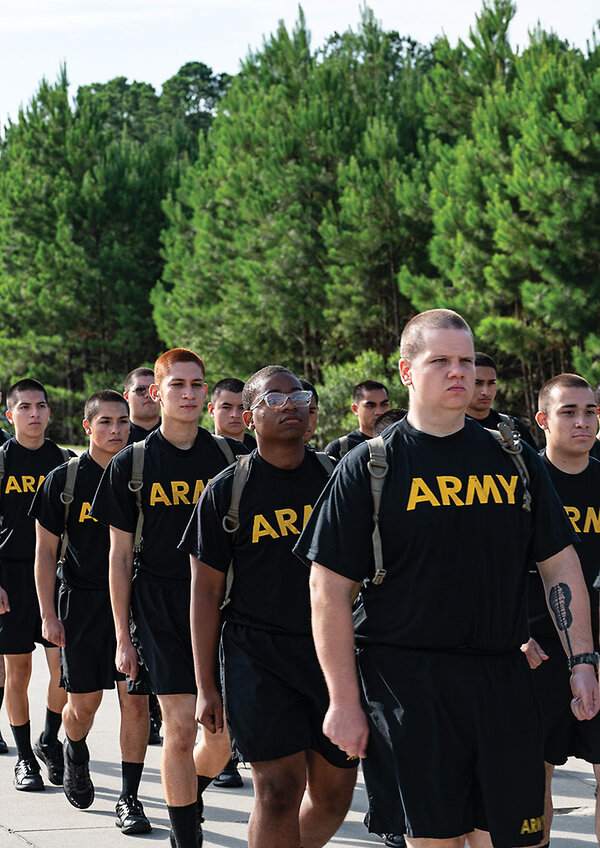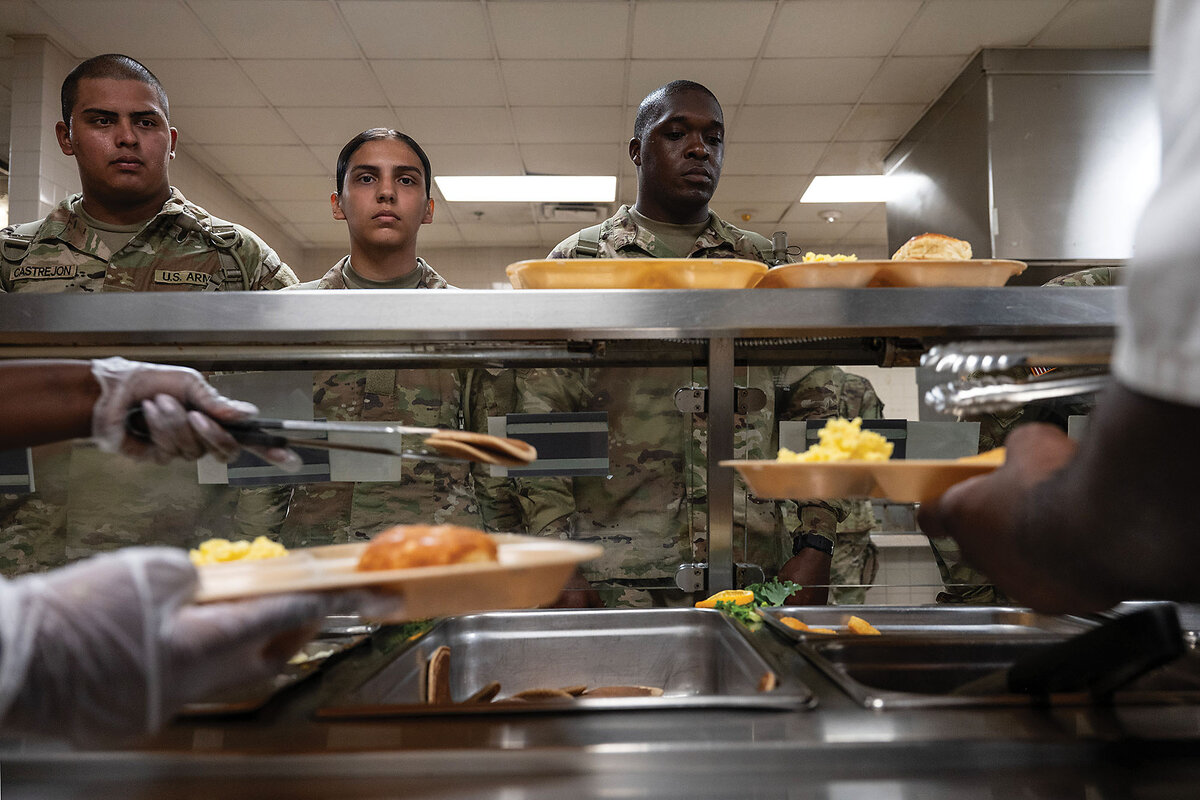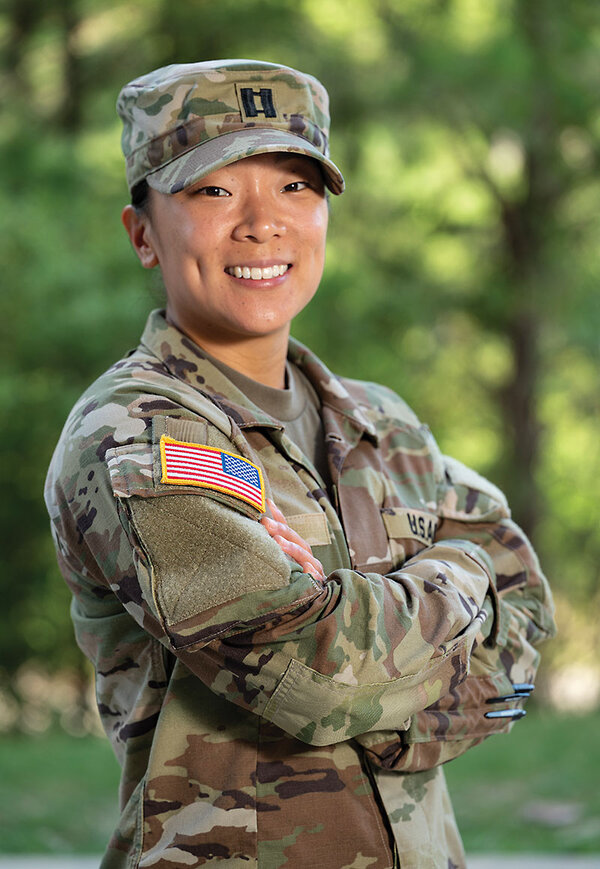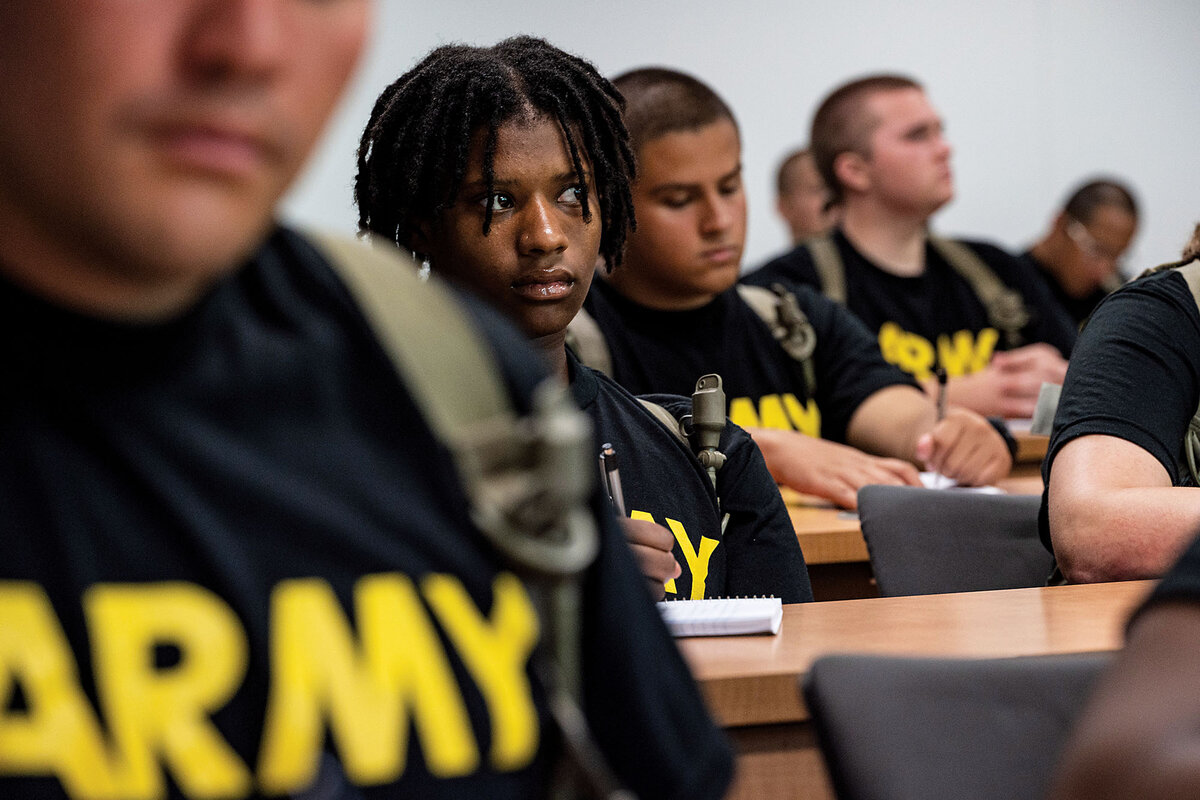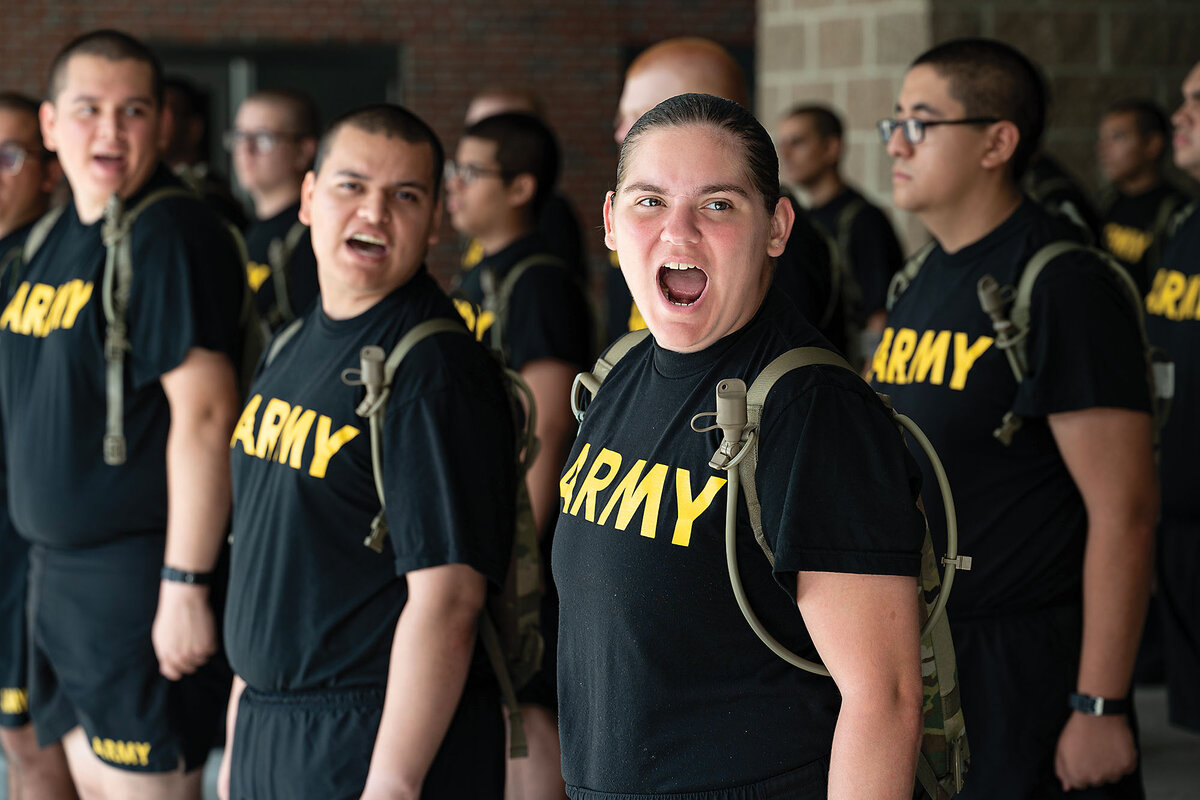No pushups? No problem. The Army builds a steppingstone to boot camp.
Loading...
| FORT JACKSON, S.C.
Bethanhi Scherer was an orphan in Vietnam when she was adopted as a teenager by her American mother and father, a FedEx executive.
She was surprised. Most families don’t go for the older children, she says. “And I’ll be honest with you – I was the most undisciplined kid coming here.”
Growing up in Georgia the past few years, Ms. Scherer was drawn to the military through her brother, who serves in Air Force special operations.
Why We Wrote This
A story focused onThe U.S. armed forces face recruiting shortfalls. Many potential recruits want to serve but don’t qualify. The Department of Defense has a plan to lift them up and make them soldiers.
“I’ve always been more of a tomboy. I like cars, guns, bikes, all that kind of stuff,” she says. But when she tried to join the Army, her written test scores, as she continued to study English, weren’t high enough.
A recruiter told her about a new Department of Defense program to boost these marks through academic and fitness coaching. If she improved and qualified, she could begin Army basic training.
The rigor of the course hasn’t been easy, but she’s highly motivated, she says. “This country saved me. I want to be a part of it.”
This is the sort of sentiment that the United States military is anxious to tap into, but one that’s increasingly tricky to find, analysts say.
The Pentagon’s advertising and marketing arm describes young people today as “having transitioned from being disconnected with the military to mostly disinterested in it,” Brig. Gen. Christopher Amrhein, who heads the Air Force Recruiting Service, told lawmakers earlier this year. The Air Force failed to make its recruiting goals for the first time in a quarter century.
At the same hearing, the head of the Army’s recruiting command, Maj. Gen. Johnny Davis, called 2024 “one of the toughest recruiting landscapes I’ve seen in over 33 years of service.”
America’s confidence in the military, while higher than most in this age of lost faith in public institutions, is currently at 60%, the lowest it’s been in 25 years.
Political polarization is driving this “wavering” esteem for the armed services, a recent Rand think tank report argues, pointing to a growing sense that the military has been politicized.
Democrats are concerned about sexual assault of troops and the presence of extremism. GOP heavyweights decry “woke” culture in the ranks. Indeed, among Republicans, confidence in the military dropped from 91% to 68% in just three years, according to a Gallup poll in June 2023.
This politically fueled skepticism has also run headlong into a strong economy where jobs are easier to find – never a boon for recruiters. And young people now have far fewer family ties to the military.
This is a particular problem. About 80% of troops have at least one family member who served, and for more than a quarter of them, that person was a parent.
When the pandemic shut down schools, it closed off a key recruiting ground for the military. The shutdown also appears to have caused military entrance exam scores to drop by nearly 10%, according to Army officials.
The U.S. armed forces are looking for recruits in new areas of the country
The Pentagon has had to rethink the way it’s reaching out to potential recruits. It’s reaching more earnestly into northern regions and more urban areas, rather than the traditional recruiting grounds of the South. It is also courting young social media influencers by offering them opportunities to create rich content – such as, say, taking a spin in a fighter jet simulator.
Still, commanders have long cautioned that their biggest recruiting challenge may be more about basic fitness. Some three-quarters of 17-to-24-year-olds don’t qualify for military service in the first place because of physical fitness levels, mental health challenges, or drug use, both recreational and prescribed.
One of the Army’s most successful new programs is targeting aspiring recruits like Ms. Scherer who want to serve but, because of academic test scores or fitness shortfalls, don’t yet have what it takes to even start basic training.
In the past, the military has been known to lower standards to bring in more recruits. This new program “is hugely important, because it addresses that critique,” says Katherine Kuzminski, director of the Military, Veterans, and Society Program at the Center for a New American Security. “It takes a population with a propensity to serve and raises them to meet the standards.”
Other services are following the Army’s lead. These initiatives and others are, in the latter half of 2024, putting the military “in a much different place right now than we were expecting,” Brigadier General Amrhein says, just six months after his testimony before Congress. “If the trend lines continue, I will move from cautiously optimistic to confident.”
Brigadier General Arnheim and others warn, however, that there will continue to be great and potentially difficult-to-meet demands for troops in the years to come.
Against the backdrop of Russian revanchism, the war in Ukraine, and rising Chinese military might, Pentagon leaders stress the need to plan for future wars against “peer” adversaries, those with high-tech weapons and armies built to challenge the U.S. military.
This is happening while politicos from the U.S., Europe, and the Far East debate reinstating the draft as they eye present-day battlefields – ferocious reminders that for all the technology deployed, wars still require the sacrifice of legions of troops.
One solution: the U.S. Army’s Future Soldier Preparatory Course
Half a world away, shredded rubber tires blanket the ground, creating a soft landing for young Americans in the “PT pit” at Fort Jackson’s Future Soldier Preparatory Course.
This is where the physical training happens. A training brigade that once taught the basics of combat has now been assigned to improve test scores and bring potential recruits up to the minimum level required to join the U.S. Army.
Some of the aspiring soldiers here have failed to qualify once, twice, or maybe even three times. Should they succeed in passing the prep course, their reward will be boarding a bus for basic training.
The junior officers supervising day-to-day training helped build this program from the ground up two years ago, given only general instructions from top brass.
“We were told the Army has a recruiting program,” says Capt. Natalie Rodgers, a Citadel graduate and, up until this assignment, a military intelligence specialist. “We kind of built the plane in flight.”
They had a sense the program was a chance to bring in enlistees who might not have felt able, or welcome, to serve. In the process, they wanted to shatter some stereotypes, such as the notion that training has to be hard-core to be effective.
This created an opening to delve into some psychology as well. Capt. Emily Rice, a registered dietitian who helped develop the program, is passionate about food choices. She’s delighted to chat about, say, the macro and micro nutrients of “meals ready to eat,” or MREs, or how to best “field strip” meals for soldiers at war or recruits during training so packaging and desserts don’t add to their pack loads.
But the officers here also knew they had to build mental fortitude in their new arrivals, she says.
“A lot of [trainees] will come with their battle buddies, and then they may not see the progress they want right away,” she says. “They end up staying when all their buddies have left them. So the resiliency, the coping skills, are really important.”
Program organizers envision transforming the role of the traditional drill sergeant. Instead of administering high-intensity, in-your-face preparation for battle, they take on a role more closely resembling coaches and confidants.
Before the prep course started, there were some on the training staff “who’d never taken off their drill sergeant hat,” Captain Rodgers says.
In this program, a sergeant’s job includes checking in on academic progress, occasional tutoring and counseling, and patrolling the chow hall. Some trainees arrive with dietary preconceptions, like “a fear of carbohydrates,” Captain Rice notes.
“So we actually walk around and look at each individual trainee’s plate,” says Senior Drill Sgt. Benjamin Thomas. “You see some with one small piece of protein, loaded down with salad. That’s not enough to actually sustain you for what we’re doing here.”
After meals, trainees are sometimes instructed to walk a few laps around the track, to aid digestion and simply help form good exercise habits. They are also given “reflection time,” which might involve writing in a journal.
Throughout the program, the “f-word” is not allowed – as in, calling anyone “fat.” They chart progress with a tape measure rather than a scale, since trainees are adding muscle weight.
The U.S. military’s recruiting standards: Is it becoming soft, or too “woke”?
The program’s leaders know there are concerns their approach might sound a bit “woke,” or soft. Can such techniques really put trainees on the path to becoming battle-hardened soldiers?
“When it first started, there were a lot of negative connotations around this program. Are we letting in the fat kids? Have we dropped Army standards?” Captain Rodgers recalls.
In fact, the prep course has shown that with the work they do here, trainees repeatedly are able to meet military standards. This alone “has helped change the culture within Fort Jackson, within their mindsets, and within the Army,” she says. “They are future soldiers, and we are helping them reach their goals.”
The program isn’t easy, however. It is essential that trainees hold fast to the goal of qualifying for basic training. Within 48 hours of their arrival, trainees are asked to reflect on their motivations for signing up and write them down.
It’s these “whys” for military service that will help sustain them during their time here, Captain Rodgers says.
Taped to a dry-erase board at the front of the cardio room, a patchwork of index cards lists some of these whys. Many are testament to the privations as well as to the prospects of life in America.
“I am very new to the States and I am an immigrant,” one card says. It also expresses gratitude for “this opportunity to bring my family to me and start with a secure career.”
“To better myself, help my family, in particular my grandmother,” expresses another.
“To make my dad proud from above,” in yet another.
Adam Hannon, who’s in his early 30s, recalls seeing an ad for a $35,000 Army enlistment bonus. He and his wife, who have four children, own a coffee shop in Ohio. (“It’s kind of like a little trailer,” he says.) “I was, like, ‘Well, that would work for me.’”
A baker by training, he has a particular affinity for wedding cakes. But Mr. Hannon says Army Special Forces “has always been a dream of mine.”
It’s also something his dad wanted for him, he adds. “But with four kids and stuff, life kind of gets out of your hands.”
His wife encouraged him to sign up for the prep course. “She’s, like, ‘Well, if you’re going to do it, do it now. Do it for the kids.’” If he passes the course and makes it to basic training, he plans to put in for an assignment in an airborne infantry unit.
Others trainees are younger – not much older than kids themselves – and they are looking for a new life.
“My parents, both of them, got locked up in prison in 2018,” says Jasmine Greene, who’s 18 years old. “And a lot of people used to say I’d end up like my mom. So I try to prove them wrong.”
She failed her first written test to qualify for military service. “The first recruiters office I went to laughed in my face,” Ms. Greene says. “They said, ‘You know, you’re not going to make it.’ So I walked out and went to a different recruiter.”
The next recruiter told her about the program at Fort Jackson. “He was, like, ‘I understand how you moved a lot, with missing your schooling and dealing with not-good parents,’” she says.
Much of the focus at Fort Jackson is geared toward slowly assimilating trainees into Army life. They enforce the kind of good eating and exercise habits these hopefuls may never have learned before, let alone been able to put into practice, says Capt. Jet Oliamot, who helps run the academic program.
“We have soldiers who had to juggle a job outside to provide for their families. Plus school. Plus lack of sleep, lack of nutrition.” Many are from “systemically poor neighborhoods,” he says. “We have some pretty smart kids. They just need some tools.”
There are study halls and mandatory lights-out. Inside the classroom, the presence of drill sergeants helps keep distractions to a minimum.
“The benefit for the teachers is that they can focus on instruction, right?” Captain Oliamot says. “You talk to any teacher in the U.S. – classroom management is a big part of their job, right? They don’t have to worry about that here, because the drill sergeants are going to take that piece.
“It’s a very rigid and regimented schedule here. They’re not used to it,” he adds. “They do not like it. Which is fine, because that’s part of the challenge. And guess what? You’re going to take that grit to basic training.”
To date, the Future Soldier Preparatory Course has graduated some 14,000 freshly minted recruits. Of these, 95% go on to finish basic training and become soldiers, according to the Pentagon.
The number of the course’s graduates selected for leadership roles during basic training is “notable,” Army Secretary Christine Wormuth recently said. They fill more than one-third of these posts.
When they board the bus to basic training, some take their “why” cards with them for inspiration. Others give them to a battle buddy. Still others leave them posted at Fort Jackson to motivate those yet to graduate.
“Those are lessons I need to learn that not everything’s going to be perfect,” says Ms. Scherer, the adoptee from Vietnam. “Not everything’s going to go your way. But I’m here. And because of my background, I know how to work hard. And I will be overwhelmed with happiness to pass this.”
The Pentagon is seeking new ways to spark connections to military service
Growing up in Milwaukee, Major General Davis, an officer in the Army’s recruiting command, recalls sitting in the garden with his grandfather, listening to stories about his time in the military. “I was surrounded by a wonderful community of veterans.”
They taught him the importance of service, he says.
Brigadier General Amrhein, head of the Air Force Recruiting Service, grew up in an Air Force family. His father was a pilot, as is he. His daughter, now in college, will soon be on her way to Air Force pilot training, too.
This kind of life of service has been a cornerstone of his family, he says. And it has been kept alive by the kind of community they’ve found within the armed forces.
For that reason, Brigadier General Amrhein believes one of the keys to attracting new recruits is to give them a reason to join – particularly among those who have had far less exposure to the military way of life. So recruiters must find new ways to spark these kinds of connections.
These connections are essential to bridging the widening divide between civilians and the military. Exacerbated by politics, the gap exists in large part, analysts say, because only 1% of all U.S. adults have ever fought in America’s wars or served during times of peace.
Young adults in urban areas in the North and bigger cities in the South are a particular demographic for the military today. These are difficult recruiting areas, however, since the majority of large U.S. military bases are near small towns in the South.
To entice civilians and expose them to military communities they might not otherwise have reason to know, the Air Force has been opening up military bases for baseball clinics and spins in fighter jet flight simulators.
Attendees “are posting on social media spaces” as a result, Brigadier General Amrhein notes. “That’s where this impact goes beyond just the immediate community. If you don’t have any experience, or even some common knowledge of it, it’s really hard to recommend.”
Major General Davis says that another promising new effort is to try, when possible, to let recruiters serve in their hometowns, to help build community affinity and trust.
The Army is also reaching out to local Veterans of Foreign Wars groups to link veterans up with young people. It is also training recruiters with courses that build negotiating skills, now necessary amid so many military skeptics.
At the same time, the country’s armed services are finding ways to address the changes in youth culture. The Air Force has adjusted its restrictions on neck tattoos “a little bit,” expanding the permissible parameters around the neck “because that seemed to be a barrier for service,” Brigadier General Amrhein says.
The Air Force also “accelerated the path to citizenship” for legal permanent residents who serve, enabling them to be sworn in as citizens shortly after completing basic training.
“That seems to be a pretty viable incentive for many people, and it opens up more opportunities,” he adds. “That’s really what we’re talking about – opening up opportunities.” Other services are considering launching their own version of the Army’s Future Soldier Preparatory Course.
And at the moment, both the Air Force and the Army now appear to be on track to meet their recruiting goals this year. Army Secretary Wormuth told The Associated Press this summer that she thinks the prep course has been a key reason.
Since this story was reported, Ms. Greene, Mr. Hannon, and Ms. Scherer have become privates in the U.S. Army.
Reflecting on her time at Fort Jackson, the teenage Private Greene says she struggled while she was there, no doubt.
“But it makes you feel motivated, having people actually sit down and want to teach you, to help you serve, to do the job you want to do, to maybe keep going.
“I knew I couldn’t give up,” Private Greene says, “because the Army didn’t want to give up on us.”






